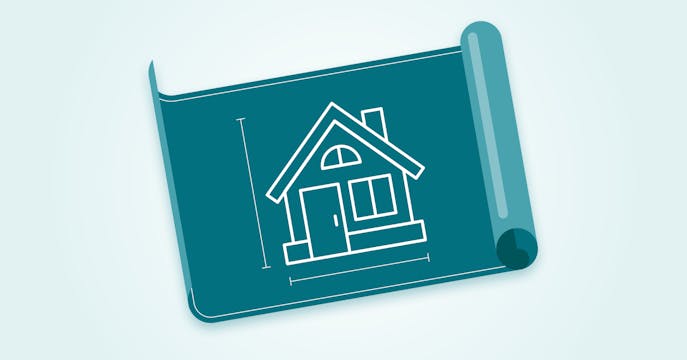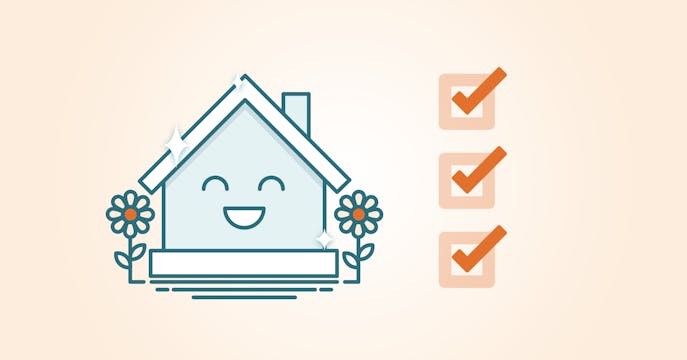Lowest Mortgage Rate in Canada. Starting from 2.49%
Your Winter Home Maintenance Checklist
Brrrr, help your house survive our Canadian winter.
Maintaining your home is important — to protect your investment from harsh weather and reduce your monthly energy costs. Here are some tips and tasks to check off your list.
Check windows and doors for leaks and drafts
You pay to heat your home, so keeping warm air inside and cold drafts out (even tiny ones) can reduce the need to turn up the thermostat. You'll also prevent moisture from creeping into frames, walls and trim.
- You may be able to feel cold air coming in around your windows and doors. Use caulking, weather stripping, door sweeps, or other products to seal gaps.
- Place your hand on your front and back door when it's cold outside. If they feel colder than the inside of your exterior walls, it may be time to install a more energy-efficient (well-insulated) door.
- Exterior door frames can expand and contract over the seasons. Adjust doors that are ill-fitting or 'bind' when opening or closing to neatly fit inside the jamb once again.
- Put up window film or insulated curtains to help prevent cold air from entering the room after the sun has gone down (especially on north-facing windows that don't see direct sunlight).
- Are your window seals broken? If there's moisture trapped inside, your windows have lost the ability to insulate and should be replaced.
Keep gutters clear and ensure proper water drainage
Melting snow (or cold rain) should drain away from your house properly, to prevent freeze-thaw cycle damage or ice buildup in the wrong places.
- Check gutters and eavestroughs for leaves and debris, especially at ground level for unimpeded drainage.
- Eyeball your roof for loose shingles or signs of leaks.
- Pay attention to where your eavestroughs drain, or ask a professional. Draining too close to your house or pavers may damage walkways or patios, or lead to foundation cracks.
- On decks and patios, put away furniture or items that accumulate snow, or get in the way of clearing snow.
Protect entryways
Help protect your entryway floors, baseboards and doors from the winter havoc brought in by boots and coats.
- Use a rubber boot tray to contain the melt-mixture of snow, dirt, gravel and salt.
- Put down a sturdy rug to absorb moisture and trap dirt (making sure to occasionally vacuum, wash or professionally clean).
- Use a separate coat rack or hooks to hang snow-covered or wet outerwear, rather than trapping the moisture to evaporate inside your closet.
- Keep a towel or paper towels near the door to spot-wipe muddy footprints and snow, or to wipe the bottom of your door frames. This will also help protect your 4-legged family members from harsh salts.
Clear the snow and ice
Have the right equipment on hand to deal with snow and ice, or hire a service. It's often a legal requirement to keep entrances, sidewalks (and sometimes driveways) clear. Plus, your roof and trees may also need attention — to prevent ice buildup, leaks, and heavy snow damage.
- Allow easy access to brooms and shovels, and make sure they're able to handle the task (no worn-down edges or cracks). Ergonomic designs may help you handle the strain.
- Have a snow blower? Maintain and clean it, so that it's ready when you need it.
- Stock up on gravel and salt.
- After large snowfalls, check outside vents and utilities to make sure they're clear.
- Clear snow from other areas as often as possible, such as patios, decks, walkways, or around steps or retaining walls to help prevent damage inflicted throughout a season of freeze-thaw cycles.
- Keep an eye on your roof if snow needs to be cleared to lighten the load (best to get professional help for this one).
Maintain your furnace, hot water tank and humidifier
- Check and replace filters (it's good to do every few months) to improve air and water flow.
- If you didn't get systems inspected during the fall, now is a great time to have your furnace, hot water tank and humidifier checked out so that they don't give up when the temperatures go down.
- Wrap your hot water tank with an approved insulation blanket, to reduce standby heat loss and lower your heating costs.
- You may be tempted to turn down your hot water tank to conserve energy, but experts recommend keeping it above a certain temperature to prevent bacteria from multiplying. Instead, install low-flow faucets and shower heads throughout your home to conserve hot water use.
Protect against frozen pipes and winter flooding
Avoid the shock — of a burst pipe and resulting flood inside your house, or equipment failure for dealing with floodwater outside of it.
- Insulate indoor pipes in colder areas of your home, like the basement or garage, to prevent them from freezing and to reduce heat loss.
- Did you drain the water leading to outdoor spigots? Close the lines inside (if you can), then drain and tape them off outside (to prevent accidental turning-on).
- When the temperature really drops, keep bathroom doors open to encourage heat circulation. But keep garage doors closed to help retain heat.
- When it's very cold, turning down the thermostat to conserve energy may result in burst pipes. When temperatures dip to extreme lows, keep your house at 21°C or above.
- If you turn on a faucet and the water pressure is really low, turn it off immediately and check for frozen pipes. If you think a pipe is frozen, call the plumber and don't turn on your water again until they say it's okay.
- Ensure that your sump pump is in working order to help protect your basement against winter storm floods. Consider installing a backup power system to run it if the power goes out.
Check on insulation and ventilation
Check your attic, roof and crawlspace to ensure vents are unblocked and that insulation is evenly distributed.
- Consider upgrading insulation to keep warm air in and cold air out (which will also help keep your house cooler in the summer).
- See icicles or ice dams forming on your roof? Carefully check that your roof and attic have enough vents for proper airflow and that they're clear (or hire a professional to check for you).
- Check your crawl space and move items away from the walls, just in case a leak develops as a result of a winter storm or burst pipe.
- Reverse ceiling fans (to rotate at low speed in a clockwise direction) to push warm air down and draw cooler air up.
Inspect the chimney, fireplace and detectors
- Using your fireplace? It should be inspected at least once a year, whether wood-burning or gas.
- Wood-burning fireplaces and chimneys can build dangerous creosote deposits which are a significant fire risk. Gas lines and valves also need regular inspection for leaks and to maintain proper ignition.
- Be sure to close the damper on your chimney when not in use, so that cooler air isn't drawn into the house.
- Make a habit of checking your smoke/fire and carbon-monoxide detectors twice annually — installing new batteries (if needed) and testing the alarms.
Stop condensation on your windows
Condensation on cold windows is a normal process: warm air carries more moisture, and has to give it up when it meets that colder window surface. However, heavy condensation will pool water at your sill, threatening water damage and mould growth.
- Even though having a humidifier in the winter helps to keep your thermostat down, having the humidity up too high, especially in low temps, will increase the condensation. You may need to turn it right down during extreme dips or improve circulation enough to keep your windows clear.
- Position blinds at a slant and open drapes to encourage airflow.
- Make sure vents under windows and beside doors are open and unblocked.
- Consider adding moisture-absorbing products (or a rolled-up towel) to your window sills (changing them as needed).
How's your garage faring?
Not everyone uses their garage the same way. Whether you use yours as a hangout, for handyperson work, or for storage (or to actually store your vehicles) — your garage is a rather large portal to the outside. It can affect your in-home heating or require expensive maintenance as a result of winter weather factors.
- Consider insulating your garage walls to reduce heat loss from your house.
- Check your garage door-opener equipment for possible signs of failure in frozen weather.
- Inspect the garage door and person-door for leaks and drafts.
- Keep the doors closed as much as possible, to prevent the transfer of warmer air from your house (or colder air into it).
- Clear snow and moisture from your garage floor (and driveway) to prevent condensation damage or it seeping into your house (if attached).
And just as important, have a survival kit and family escape route ready
Fortune favours the prepared, so here's a list of things to get ready in case of an outage or if a quick escape is needed.
- Put together a survival kit. You never know when the power may go out, or for how long. Or if your furnace or water halts, you may need to buy some time before help arrives:
- Include bottled water, candles, matches, blankets, flashlights, a radio, batteries, food and snacks (that will keep for a time), a first-aid kit, and toiletries such as hand sanitizer and tissue. Also include any special items, such as diapers and formula, or pet food.
- Next winter, remember to double-check expiry dates on your supplies.
- Plan out an escape route, or what to do if an emergency happens and you need to leave immediately. Make sure to rehearse with little ones in a relaxed manner, so they'll be less nervous.
- Have your important items in one place in case you have time to grab them, such as wills, financial papers, photos, extra keys, etc.
- Don't forget about your pets — designate a person to be in charge of gathering your furry (or feathered or scaled?) family members in the face of chaos.
Please note that the above tips are considered best home-maintenance practices; however, details and results may vary.
Check up on your home now — it may save you money and stress later.
Blocking off a couple of hours to check up on items and systems can help you spot issues and fix them before they get worse or result in sudden damage when you least expect it. You can also use the time to improve the energy efficiency of your home to keep monthly utility costs down.
Face the Canadian winter while being better prepared. And when you're all done your checklist, enjoy the winter season!
Want great tips for saving money on your mortgage? We're here for that, too.
More mortgage tips

Proof that our rates are lower.
Our rates are 0.18% lower on average compared to everyone else. Prove it? Okay!

New Home Details Wishlist
"I wish we thought of that!" Get ahead of design regret with this helpful list.

Your Spring Home Maintenance Checklist
Spring into action for home fixes and maintenance to protect your investment.

